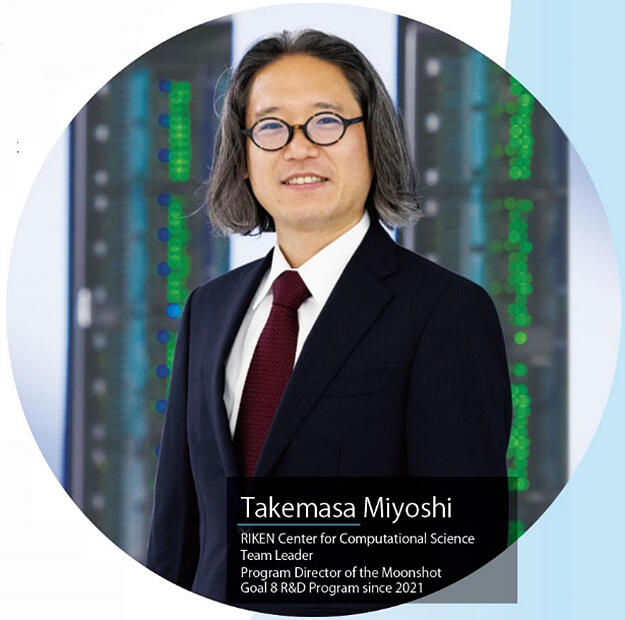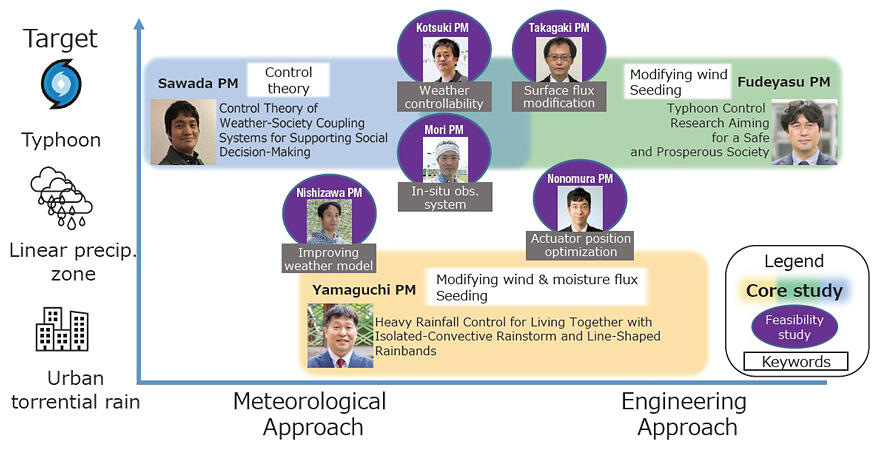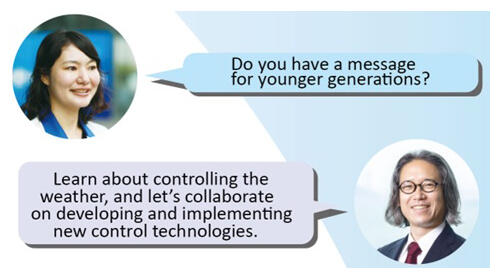In this interview, we are introducing the Moonshot Goal 8: "Realization of a society safe from the threat of extreme winds and rains by controlling and modifying the weather by 2050." The program aims to realize this goal by researching simulation technologies to enable control of these complex atmospheric conditions, develop control methods, and implement them in society. Yu Hoshina, a Science Communicator at Miraikan - the National Museum of Emerging Science and Innovation, interviewed Dr. Takemasa Miyoshi, Team Leader at the RIKEN Center for Computational Science, who also acts as the program's director.


Mitigating extreme wind and rain damage by controlling the weather
Hoshina: The concept of controlling typhoons and torrential rains is probably unfamiliar to most people. What does it imply?
Miyoshi: Well, you can liken it to controlling a rocket. A rocket's trajectory can be changed by adjusting the engine's output. Changing the output doesn't just change the rocket's trajectory but allows us to control its direction. Under Goal 8, which aims to realize a society safe from the threat of extreme winds and rains by controlling and modifying the weather, weather control involves reducing the intensity of rain and wind to mitigate the potential for major disasters.
Hoshina: Has humankind ever successfully controlled the weather?
Miyoshi: Weather modification, such as seeding water vapor nuclei into the atmosphere to induce rain in drought‐stricken areas, has been conducted. Our goal with weather control is different; we aim to intervene in the atmosphere to change weather conditions for as little as 30 minutes to an hour or even up to several days into the future. However, the chaotic nature of the weather means slight differences in conditions can result in significant changes, making it challenging to predict extreme weather events such as typhoons and torrential rains. I think these are reasons why weather control has not been proposed until now.
Hoshina: So, why did you take on this challenge now?
Miyoshi: My research on weather forecasting focuses on data assimilation, a technique that combines simulations with observations to increase simulation certainty. As part of my research, I've been using the Kalman filter, initially developed for controlling rockets and electronic circuits, to improve the accuracy of weather forecasts. Although this data assimilation method has been used to improve the accuracy of weather forecasts, it has not been used for control. I believe that focusing on this technique could help us control the weather. Accurate prediction of chaotic weather requires a large number of calculations, and high‐performance computing is essential for such calculations. In Japan, we have access to supercomputers such as Fugaku, which gives us an advantage in this area.

Realizing weather control through combining engineering methods and simulation techniques
Miyoshi: Project Manager (PM) Fudeyasu is researching ways to weaken typhoon development by seeding materials into them using airplanes or other means, similarly to existing weather modification methods. This technique suppresses their growth by simulating cloud formation and selecting the appropriate location and timing. Meanwhile, PM Yamaguchi is studying methods to control heavy rainfall. One approach involves creating an offshore curtain to block water vapor from the ocean. Another approach he is investigating involves using offshore wind turbines for power generation to prevent water vapor from collecting or to change the wind flow.
Hoshina: Those are some truly unique approaches.
Miyoshi: Many other researchers and engineers that are not involved in this project must possess technologies for changing atmospheric conditions. However, they may not believe their techniques can be used to change the weather. Therefore, we hope to engage with these individuals to explore additional control methods. Furthermore, having a diverse range of control methods available lets us choose or combine the most effective methods depending on the situation.
Hoshina: How can the results of influencing the weather be evaluated?
Miyoshi: Because weather is chaotic, it's impossible to forecast future conditions precisely. However, by running multiple simulations, we can create probabilistic predictions that cover a broad range of possible outcomes. We believe that evaluating control will involve assessing whether the results make an event less likely to occur compared to taking no action and how closely the outcome aligns with the desired state.
Hoshina: Will these techniques be used to intervene in actual typhoons and torrential rain events?
Miyoshi: Our goal is to be able to control the weather by 2050, but first, we need to ensure the technology is effective and safe while gradually expanding its scale. Many technical and societal challenges must be overcome before atmospheric interventions become a reality. To address these challenges, PM Sawada is developing a theory of weather control that proposes a method for changing highly‐energetic typhoons into an amount of energy that humans can control. Additionally, he is investigating the kinds of conditions that various stakeholders can agree upon. By around 2030, we plan to conduct small‐scale experiments on clouds that pose no disaster risk after fully validating the theory and technology through numerical simulations and indoor testing.

Collaborating with citizens to develop new technologies
Hoshina: Can human intervention eliminate damage from typhoons and torrential rains?
Miyoshi: It depends on the individual phenomenon. In certain situations, it might be possible to prevent any damage from occurring, while in others, it may be challenging to predict the risks and respond quickly, resulting in limited control measures. While it's difficult to completely eliminate damage, even a slight reduction in rainfall could decrease harm and provide additional time for evacuations.
Hoshina: So, infrastructure like levees will continue to be needed?
Miyoshi: Our objective is not to completely eliminate extreme weather but to control it enough to prevent damage. Even if weather forecasts are accurate, controlling the weather may not be enough to prevent all harm. Therefore, combining effective control measures with dams and levees will be crucial. We aim to establish a crisis management strategy integrating weather control and existing infrastructure to create a safe society.
Hoshina: What about problems that might arise from controlling the weather?
Miyoshi: Reducing disaster damage in one area through weather control must not damage other regions. This could happen if we indiscriminately avoid typhoons and heavy rainfall and may lead to unintended consequences. It may also lead to outcomes such as droughts. To prevent these adverse outcomes, it's crucial to thoroughly evaluate the possibility of unintended consequences and implement weather control under appropriate guidelines with both regional and international agreements.
Hoshina: What factors are necessary for weather control to gain widespread acceptance?
Miyoshi: Promoting open international scientific research and development and discussing weather control in society are essential. Collaboration with domestic and international stakeholders is necessary to identify available technologies for controlling typhoons and torrential rains, the potential impacts of their use, and any relevant concerns. Defining the guidelines and standards for the use of weather control in society should also be a responsibility shared with society.
Hoshina: What kind of society do you envision for 2050?
Miyoshi: Climate change is expected to result in more frequent typhoons and heavy rainfall disasters in the future. To mitigate these threats, we must fully leverage science and technology. Our goal is to expand the use of weather control to free ourselves from the threat of disasters.




